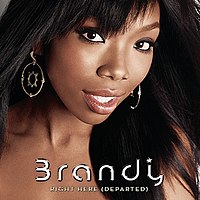Piano Sheets > Brandy Sheet Music > Right Here (ver. 1) Piano Sheet
Right Here (ver. 1) by Brandy - Piano Sheets and Free Sheet Music

About the Song
"Right Here (Departed)" is a song by American singer Brandy, written by Rodney "Darkchild" Jerkins and The Writing Camp members Evan "Kidd" Bogart, Victoria Horn, Erika Nuri, and David "DQ" Quiones and produced by Jerkins for her fifth studio album Human (2008). Its lyrics chronicle a woman's talks about mutual support with loved ones.
Picked as the album's leading single and Brandy's first release with Epic Records, following her split with Atlantic Records in 2005, the song premiered via Brandy's official webpage on August 13, 2008. Her first release in four years, it was officially serviced to U.S. radios on August 25, 2008. The song has since reached the number one on the Billboard Hot Dance Club Play chart, as well as number 22 on the Hot R&B/Hip-Hop Songs chart and the top ten of the French Singles Chart. Brandy Rayana Norwood (born February 11, 1979), known professionally as Brandy, is.
Download this sheet!
About the Artist

Random article
Getting access to free sheet music for Christmas Christmas is one time when everyone wants to learn how to play the piano. There are so many Christmas carols, hymns and other compositions played. In such a situation, you will find it useful to get free sheet music especially with the Christmas compositions in them.
New age and classical
One of the best advantages about free sheet music is that you can get both classic as well as New Age Christmas musical notes. That means you will be able to play the old time classical compositions, carols etc. and the new artists compositions. The New Age Christmas musical notes are very poignant and lovely and playing these piano notes is sure to stir hearts. One of the drawbacks about New Age Christmas music sheets is that they are very difficult to access. Most New Age albums do not sell too well and hence the demand for these is lesser. In this context, getting access (More...)
